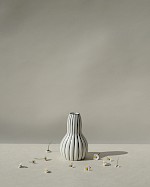Steingutfabriken Velten-Vordamm, a prominent German ceramics manufacturer, flourished between 1914 and 1931, leaving a lasting imprint on the world of modern design. Founded by engineer Hermann Harkort Jr. and merchant Heinrich Runde, the company expanded rapidly with the establishment of a wall tile factory in Velten in 1913-1914, led by the skilled direction of Karl Walch.
In the early 1920s, Velten-Vordamm became a key player in the avant-garde movement, embracing the principles of the Bauhaus school. This collaboration led to an era of bold, innovative ceramic designs that challenged traditional forms and materials. Renowned designers like Theodor Bogler, Hedwig Bollhagen, Charlotte Hartmann, and Luise Harkort contributed to the company’s distinctive aesthetic, merging functionality with art in ways that captured the spirit of the time.
However, the onset of the Great Depression dealt a devastating blow to the company, leading to its bankruptcy in 1931. Despite efforts to resurrect the brand, including ambitious plans to relocate to Marwitz and even establish a new venture in Jerusalem, these initiatives ultimately failed. Yet, the legacy of Velten-Vordamm endured as former employees regrouped in 1934 to form the HB Workshops for Ceramics, preserving the Bauhaus-inspired ceramic artistry that had once defined the company.
Today, Velten-Vordamm’s groundbreaking designs continue to be celebrated in museum collections and private holdings, standing as a testament to its pivotal role in shaping the trajectory of modern ceramic art. The company’s brief but influential existence remains a fascinating chapter in the story of 20th-century design—one that demonstrates the intersection of creativity, industry, and social change.

